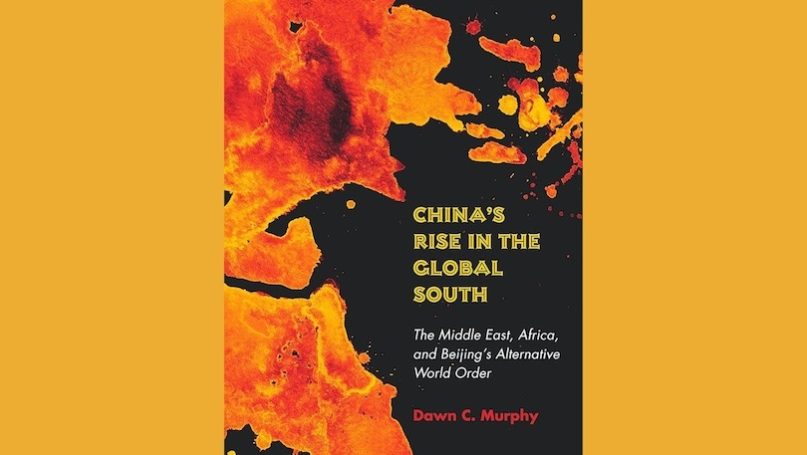
China’s Rise in the Global South: The Middle East, Africa, and Beijing’s Alternative World Order
By Dawn C. Murphy
Stanford University Press, 2022
The geo-political tension between the United States and China is often framed in the context of the rivalry in the Pacific region. Dawn Murphy contributes to this conversation with a refreshing analysis by focusing on China’s efforts in Africa and the Middle East. In these regions, she convincingly argues, China is establishing spheres of influence and is increasingly competitive against the United States and the West, challenging the rules of the Liberal International Order (p.8). Beijing’s goal is to build an alternative order that can one day displace the United States as the pre-eminent power. Murphy offers a helpful framework that conceptualizes China’s efforts into a cooperative or competitive categories of political, economic, and military actions in relation to US efforts, and whether those efforts are norm convergent or norm divergent from the Liberal International Order (p.9).
In China’s Rise in the Global South, Murphy shines light on an increasingly relevant and discussed topic in academia and in policy circles. Rush Doshi and Ketian Zhang draw similar attention to China’s efforts and global ambition. While Doshi offers a broad perspective of China’s ambitions, and Zhang provides a refined understanding of a specific foreign policy tool, Murphy’s contributions to this discussion provides a middle-ground comparative aspect of China’s foreign policy efforts in two regions of importance, Africa and the Middle East.
Murphy’s book is a great introduction to understand China’s broad political, economic, and military efforts in two regions of interest. Each topic could be a book unto itself, but the numerous, yet substantive research questions Murphy explores give an appreciation of the complex topics in a simple, but informative, style for the reader. Each chapter is easily digestible and cover the main themes of her research for each region of focus. Murphy frames the comparison by assessing the geo-political competition between China and the United States in each region. The Middle East is a region of mutual strategic interest for China and the United States, of course; while Africa is a region of interest for China, but not often a policy priority for the United States. Her portrayal provides nuance to understand Beijing’s actions that shies away from the term of revisionism that is often overused in policy analyses. Rather, her works shows a gradual displacement over time, focusing on a significant period of China’s development and influence from 1991 to 2019.
An analysis of two regions requires significant time and financial resources that are not often feasible for scholars. Thus, Murphy’s dearth of field work in Africa stands out prominently as it was limited to only South Africa. To be fair, South Africa’s strategic relationship with China, with deep historical, political, and economic connections, is worth studying if any country must be chosen. While more field work is often beneficial, she makes up for these constraints with interviews, and analysis of official documents. Particularly beneficial is her use of Chinese primary sources to amplify her narrative. While her work is largely qualitative it would have been easy, and useful, to incorporate a multi-method approach to her research. For example, Murphy provides figures on China’s arms sales to countries, but other than providing total values for time periods, there is no analysis to highlight useful trends (p.227). Arms transfers is a particularly important foreign policy tool largely because Beijing does not attach conditionality to arms transfers like many Western states. Furthermore, it would have been beneficial to review the topic of sovereign debt. China’s Belt and Road Initiative is an important policy tool that burdens states with significant debt, yet the effects of this concern are not adequately discussed. Significant ink has been spilled in the debate of ‘debt trap diplomacy’ and she largely avoids that discussion altogether.
One of the findings in this book is that China’s foreign policy efforts are characterized as competitive in its economic and political actions in the Middle East and Africa, while Beijing’s military efforts are largely cooperative. At the risk of painting a more dire picture, perhaps she overplays the cooperative aspect of China’s military efforts. Two military efforts that Murphy highlights are UN Peacekeeping Operations and China’s support to anti-piracy operations. A deeper look at China’s incentives and participation in these efforts shows that Beijing’s actions are in fact less cooperative, and more competitive than portrayed. For example, China’s anti-piracy operations in the Red Sea and Gulf of Aden were not under the multi-national efforts in the region; rather, China chose to operate independently (p.229). More telling is China’s support to UN peacekeeping efforts. Beijing’s Science of Military Strategy (2020), an official military strategy and planning document,specifies two noteworthy goals of China’s participation in UN peacekeeping missions. One is to improve the bilateral relationship with the country in which troops are deployed, and another goal is to create a good overseas investment for the future. In the government’s own written words, Beijing sees the use of its UN troops as a means to improve bilateral relations and strengthen interests. As Murphy points out, China’s UN deployment locations reflect concern on the potential impact to its own economic security (p.221). Given the above considerations, one can rightly interpret China’s military actions as competitive, rather than cooperative, as Murphy argues.
Despite the shortcoming in assessing China’s military efforts, Murphy’s work is an important and refreshing contribution to the literature portraying China’s global ambitions in two geo-politically sensitive regions. In avoiding the common Pacific and Euro-centric approaches to studying the competitive rivalry between China and the United States, her contribution in China’s rise in the global South fills a gap in the existing literature. Furthermore, this book will be useful for policymakers and scholars to understand the context in which this rivalry will occupy their work for the foreseeable future.